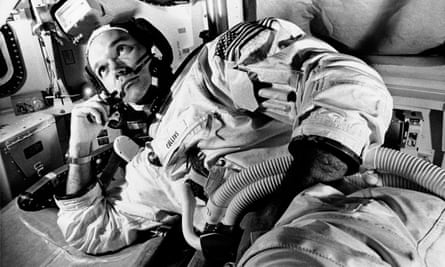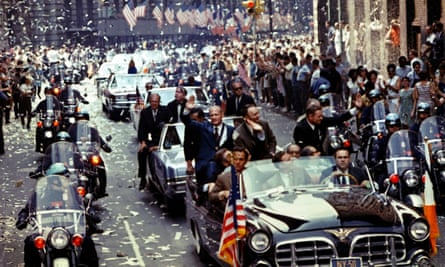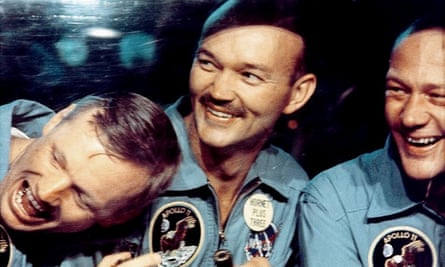On 20 July 1969, Michael Collins, who has died aged 90, became the most solitary human in the universe – even if he derided that categorisation as “phony philosophy”. He orbited the moon alone, inside Apollo 11’s command module Columbia, and out of touch with ground control for 48 minutes on each orbit. Meanwhile, and more famously, Neil Armstrong and Buzz Aldrin were becoming the first men to set foot on that rock, some 240,000 miles away from Earth.
As the command module pilot, on $17,000 a year, Collins was, he later wrote half-jokingly, “the navigator, the guidance and control expert, the base-camp operator, the owner of the leaky plumbing – all the things I was least interested in doing”. He was also, thought Aldrin, probably Nasa’s best-trained command module pilot.
A back operation had precluded him from Apollo 8, which orbited the moon at Christmas 1968. In January 1969 Collins was assigned to Apollo 11. The moon landing attempt was confirmed only after the successful Earth orbit testing of Apollo 9, and the 31 moon orbits of Apollo 10 that May. The Apollo 11 landing was more than a step in history, the New York Times would editorialise, it was a step in evolution. “We were our nation’s envoys ...” Collins wrote, “and it would be a national disgrace if we screwed up.”

Preceded by a protest by the Rev Ralph Abernathy’s Poor People’s Campaign at the launch site, and accompanied by a “go baby go” from America’s favourite uncle, CBS-TV’s Walter Cronkite, Apollo 11 took off at 9.32am eastern daylight time, 16 July 1969.
By 2pm that day Collins had separated the command and service module from the Saturn V rocket, turned it, docked with the lunar module Eagle, “nestled in its container atop the Saturn like a mechanical tarantula crouched in its hole”, as he described it, and disengaged from the dying rocket. With his companions, Collins set off for orbit, four days later, 60 miles above the “withered, sun-seared peach pit” of the moon and, for 24 hours from 2.46pm, his sole proprietorship of the “orbiting men’s room” that was Columbia.
Collins never sweated as much over any flight, he recalled, as he did over Eagle’s lunar takeoff, terrified that he alone would return to Earth. Some 850 computer punches later the astronauts were reunited, Eagle was ditched, and a 150-second “burn” broke Columbia out of the moon’s gravitational pull. On the way back, routine was enlivened by a music tape – Collins’s favourite was Jonathan King’s Everyone’s Gone to the Moon – and TV broadcasts to Earth. Close to home the service module was ditched, and the astronauts prepared for their meeting, on the USS Hornet, across a quarantine barrier, with President Richard Nixon, and global adulation.

Michael, the son of James Collins, a soldier, and his wife, Virginia (nee Stewart), was born in Rome, where his father was serving, and was later relieved that this saved him from any astronautical hometown parade. Collins Sr retired as a two-star general, one of Michael’s uncles was a sometime army chief of staff, and another was a brigadier. His brother became a colonel, and a cousin a major.
The future astronaut’s peripatetic childhood took him to Oklahoma, New York, Puerto Rico, where he first flew, and Virginia. He was educated at St Albans boys’ school in Washington DC and graduated in 1952 from West Point Military Academy in New York state. There he was in the same class as Ed White, who would be killed in the 1967 Apollo 1 fire.
Having opted to join the US air force, Collins trained in Columbus, Mississippi, then in Waco, Texas, before, in 1953, going for advanced day fighter training on F-86 Sabres at the Nellis air force base in Las Vegas, Nevada. Too late for the Korean war, he learned nuclear weapon delivery with the 21st Fighter-Bomber Wing at George base in California. Then the wing was posted to Chaumont, France, where, in 1956, he had to bail out when his F-86 caught fire, the experience boosting his confidence about handling sticky situations. An Episcopalian, while in France he married Patricia Finnegan, a Catholic from Boston.
Back in the US in 1957, Collins’s ambition was to get to the Edwards base test pilot school in California, but what he got was a grim maintenance course at the Chanute base in Illinois. He then commanded a unit training crew on new aircraft. By 1960 this meant the F-105 Thunderchief Mach 2 fighter-bomber, at Nellis. That August came his Edwards posting, which led him to fly F-104 Starfighters at an altitude 18 miles above the Earth.
Two years later he was turned down as one of Nasa’s Gemini programme “New Nine” astronauts, but in October 1963 he became one of the next 14. The aim of the Mercury programme (1961-63) had been to put astronauts in space; Gemini was about preparing for Apollo and the moonshot, working, manoeuvring and docking in Earth orbit. “With one part shrewd logic, and nine parts blind luck, I had qualified,” Collins said.
His first venture into space was from 18 to 21 July in 1966, on Gemini 10 with John Young. On Gemini 8 that March, Armstrong had made the first orbital hard docking, with an Agena target vehicle, but had been forced to end the mission after the spacecraft spun out of control – “it was getting uncomfortable,” Armstrong had understated. Gemini 9 was also dogged with problems, but Gemini 10 was a triumph – even though Young and Collins were criticised by ground control for being too taciturn.
Collins spent 89 minutes on “extra-vehicular activities” (spacewalks) on Gemini 10, once “gliding across the world in total silence, with absolute smoothness; a motion of stately grace which makes me feel God-like as I stand erect in my sideways chariot, cruising the night sky”.
The Agena docking was successful and propelled the twin craft to a then record 475 miles – and a rendezvous with Gemini 8’s abandoned Agena from which he took an experimental micrometeorite package. However the astronauts’ eyes began watering and they were temporarily almost blinded after what was believed to be a leakage of lithium hydroxide from canisters into their space suits. And what Collins called some of “the most spectacular pictures ever taken in the space programme” were lost when his camera spun into the void.
Even before Apollo 11 took off, Collins had decided that, unless the mission failed, it would be his last. Subsequently he left the USAF as a colonel, was briefly an assistant secretary of state under Nixon – quitting before he got “gout and a faintly British accent”, and then spent time as director of the National Air and Space Museum in Washington DC.

His many honours included the presidential medal of freedom, awarded in 1969. Having witnessed the Earth from afar, he became a serious ecology advocate. He described himself as a perpetual optimist, perfectly satisfied with his role on Apollo 11, and appeared in a documentary film, In the Shadow of the Moon, 2007, about Nasa’s lunar missions of the late 1960s and early 70s. Latterly he professed himself irritated by the cult of celebrity.
In 2019, on the 50th anniversary of the moon landing, he said: “I may, in normal times, go a month or two without thinking about it. But when I do, it comes back with a great deal of clarity, more than I would have guessed.”
Collins wrote several books, including the splendid Carrying the Fire (1974), which was dedicated to his wife. Patricia died in 2014, and their son, Michael, in 1993.
Collins is survived by two daughters, Kate and Ann, seven grandchildren and a sister.
Michael Collins, astronaut, born 31 October 1930; died 28 April 2021

Comments (…)
Sign in or create your Guardian account to join the discussion